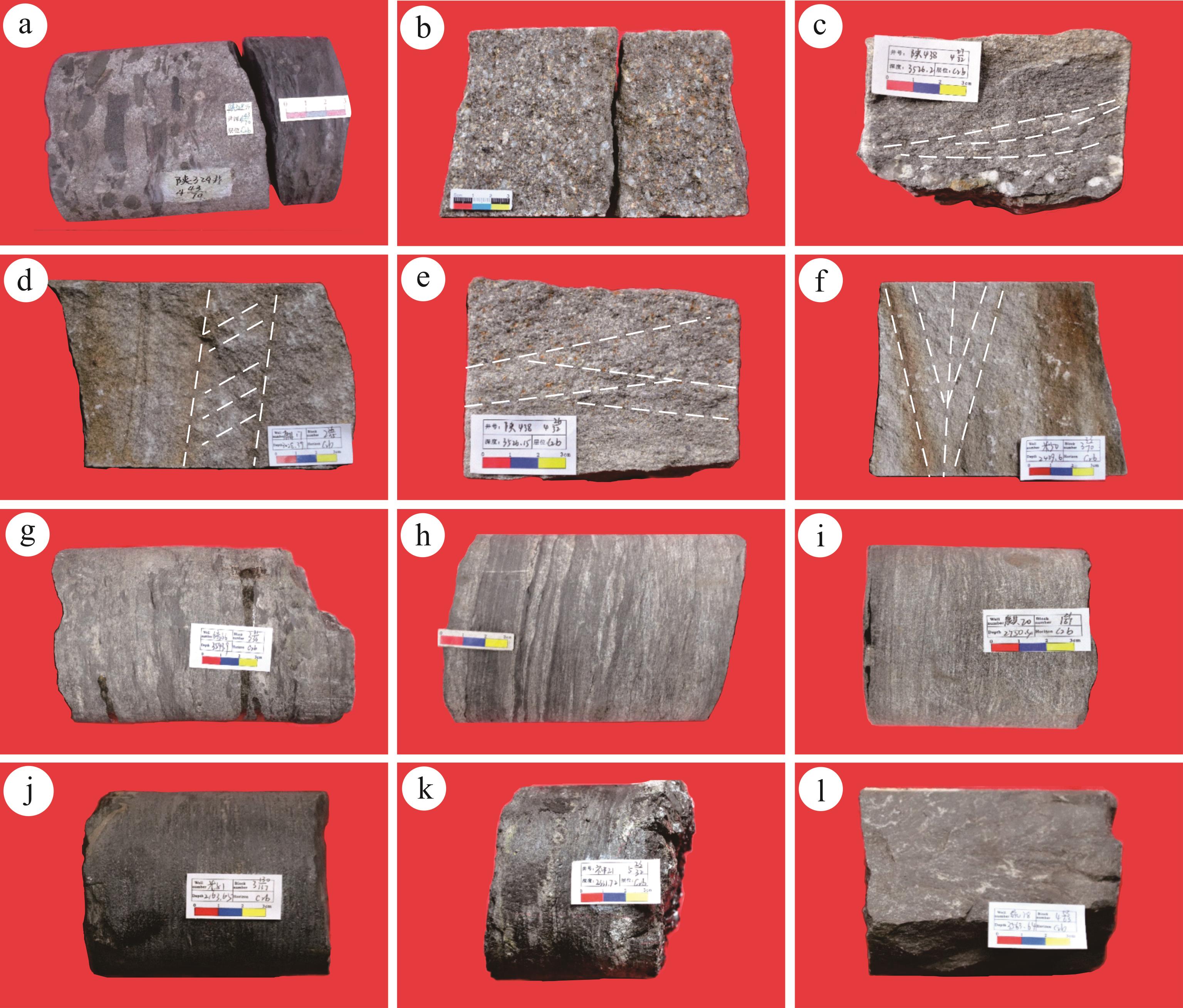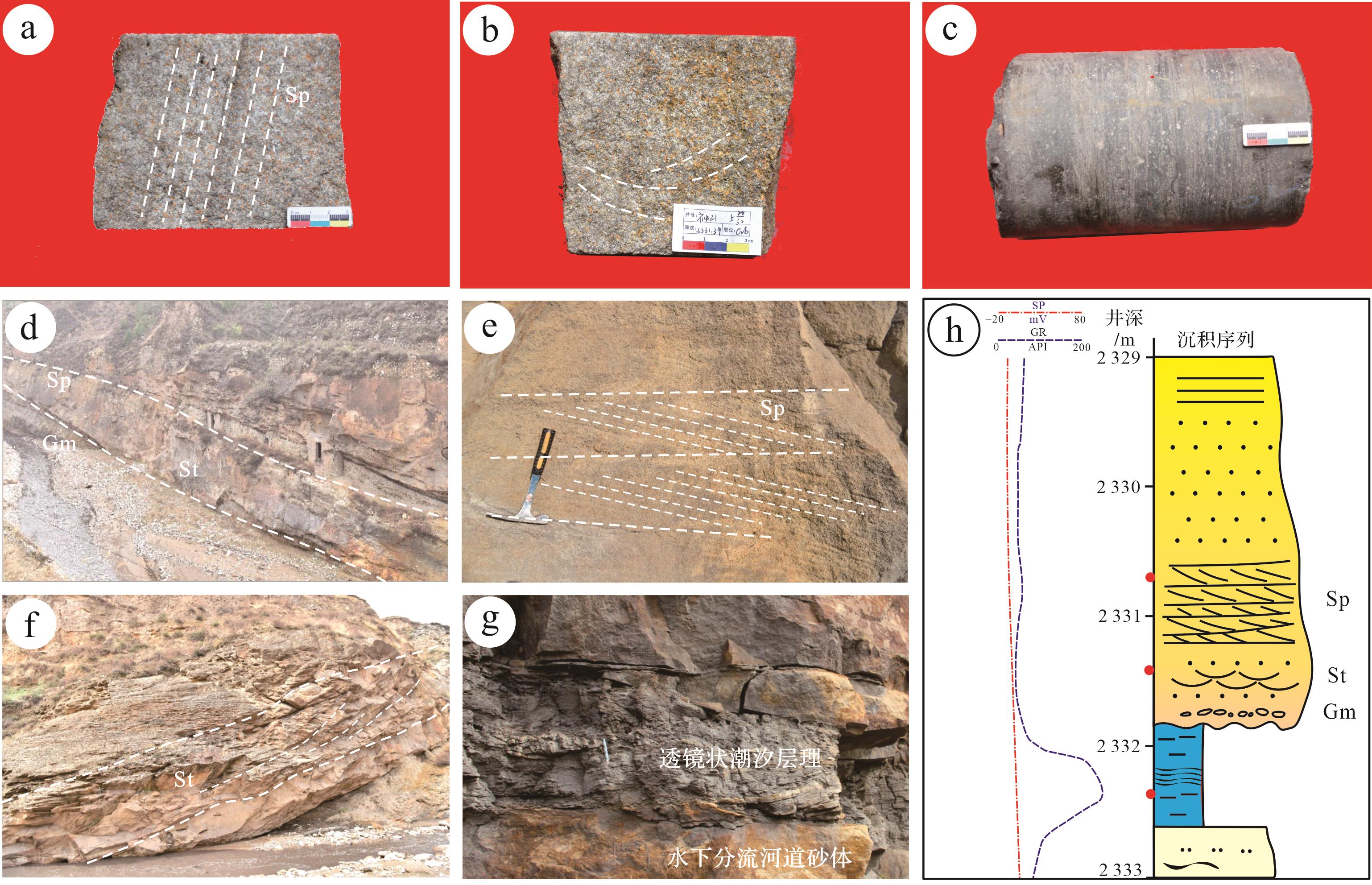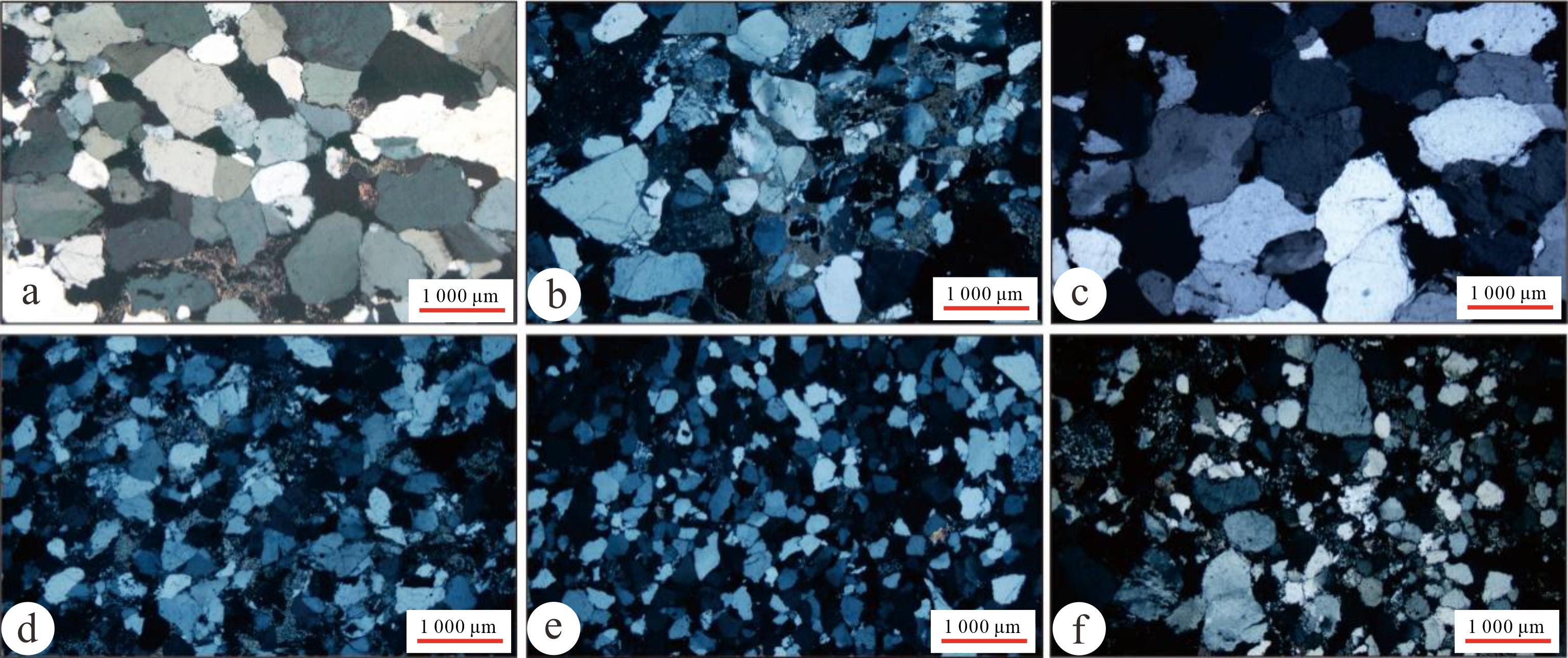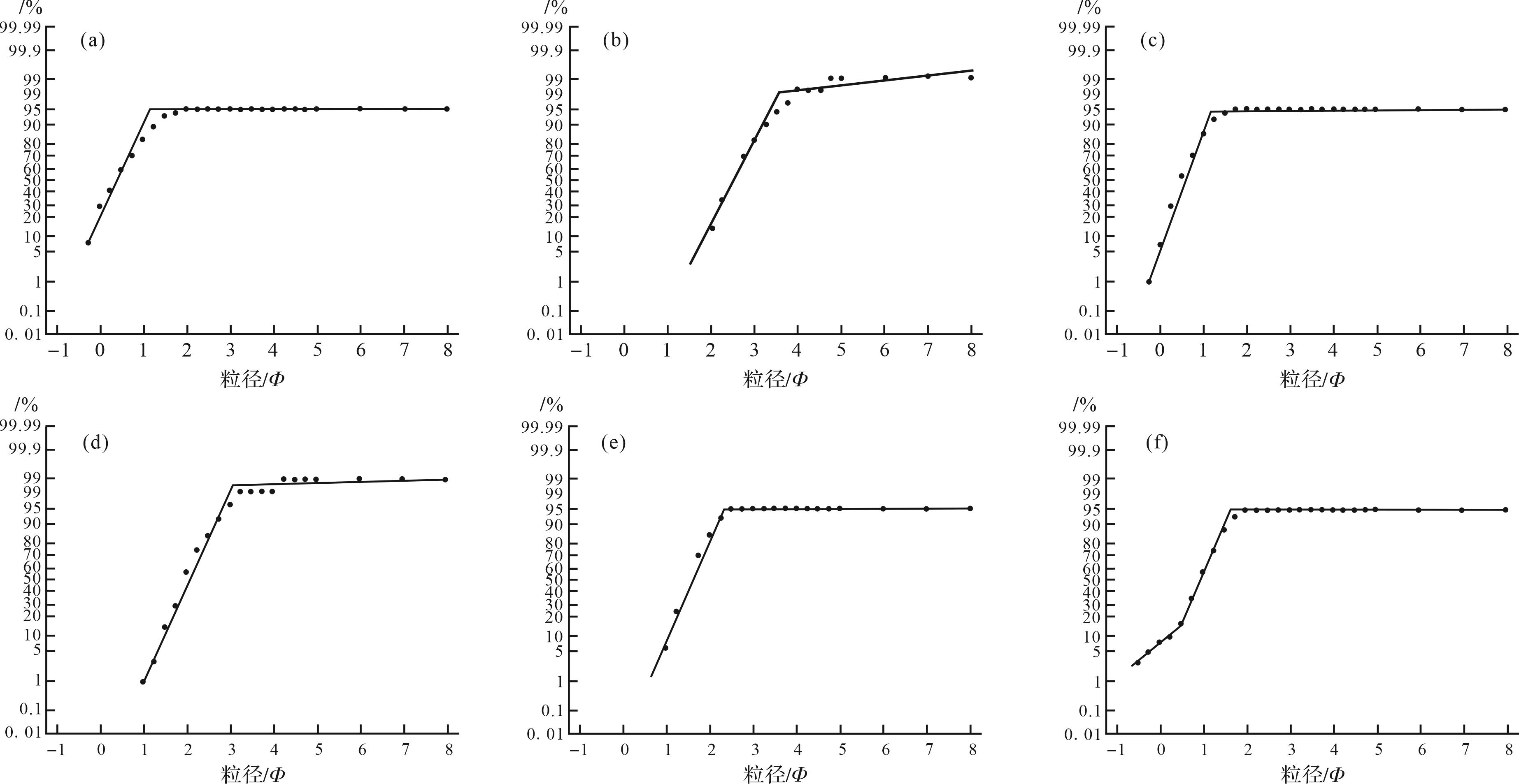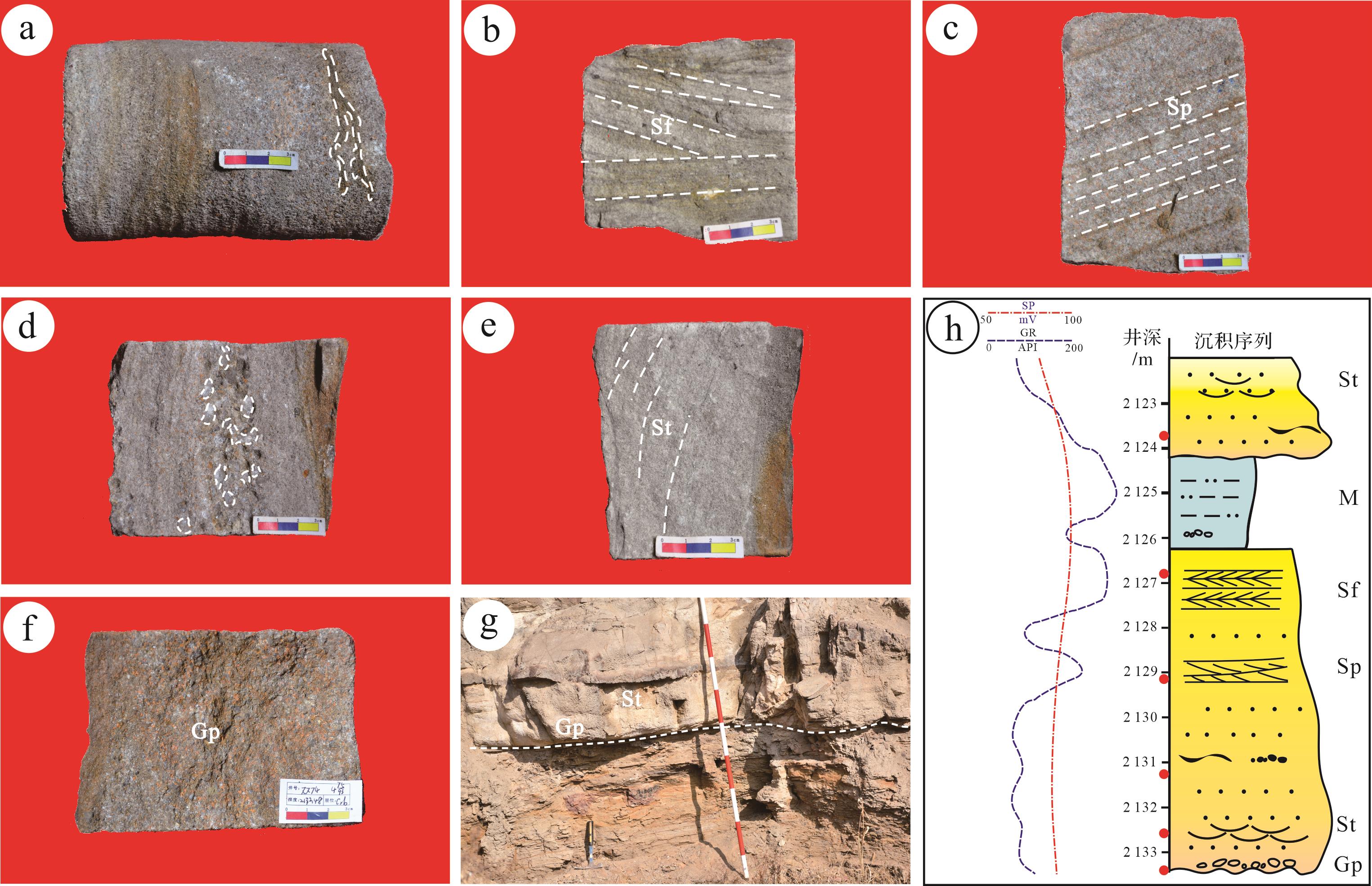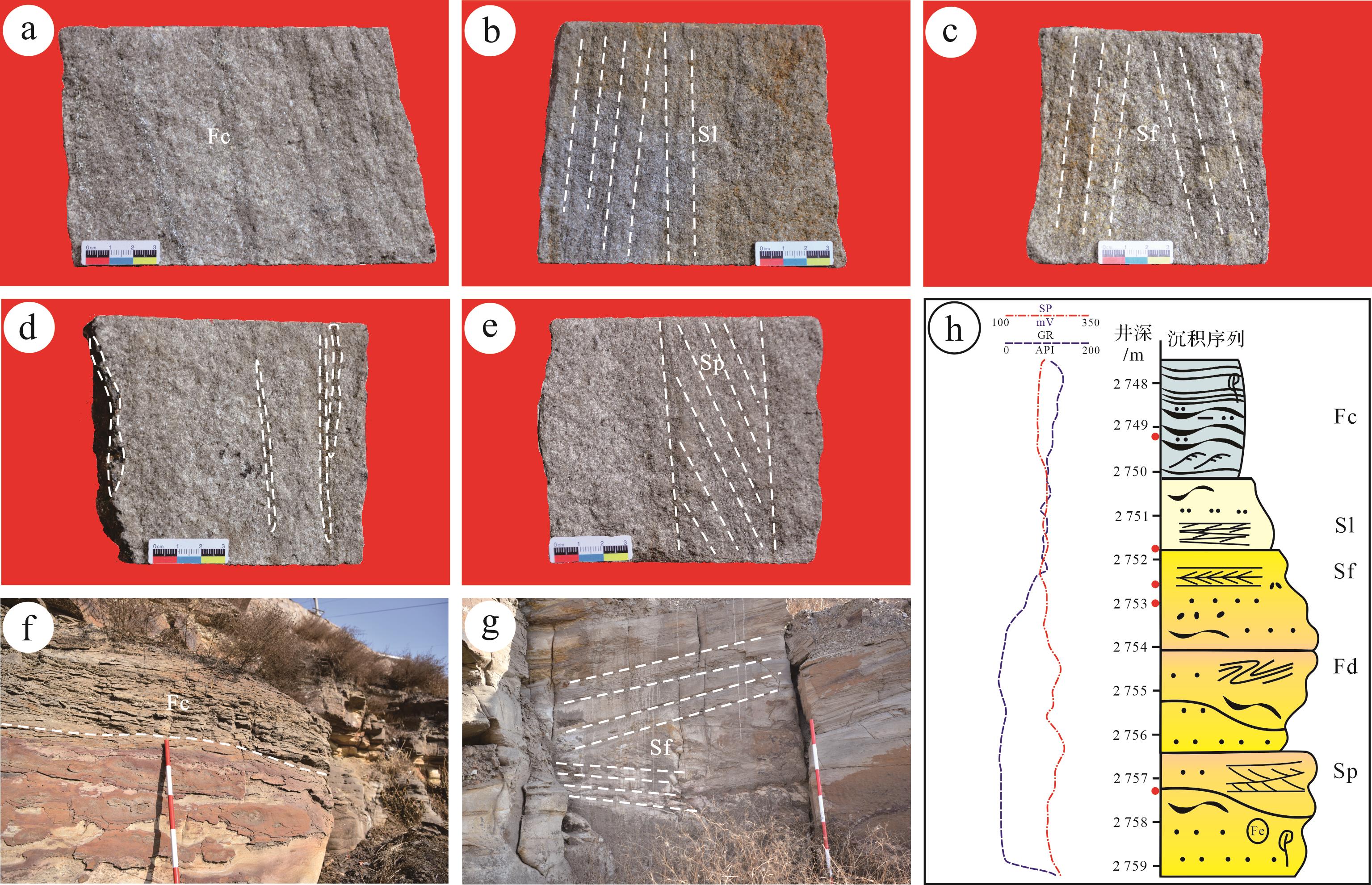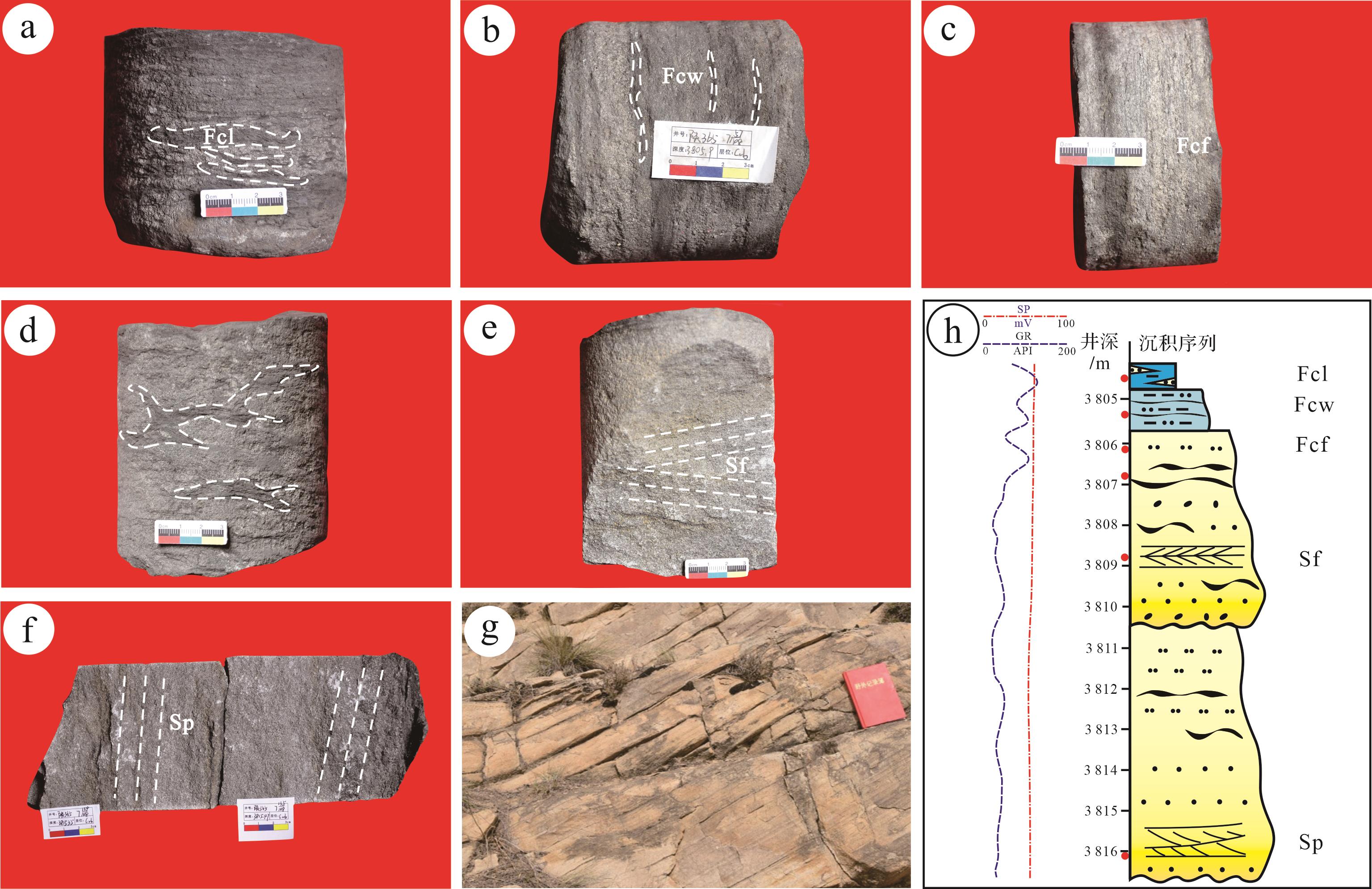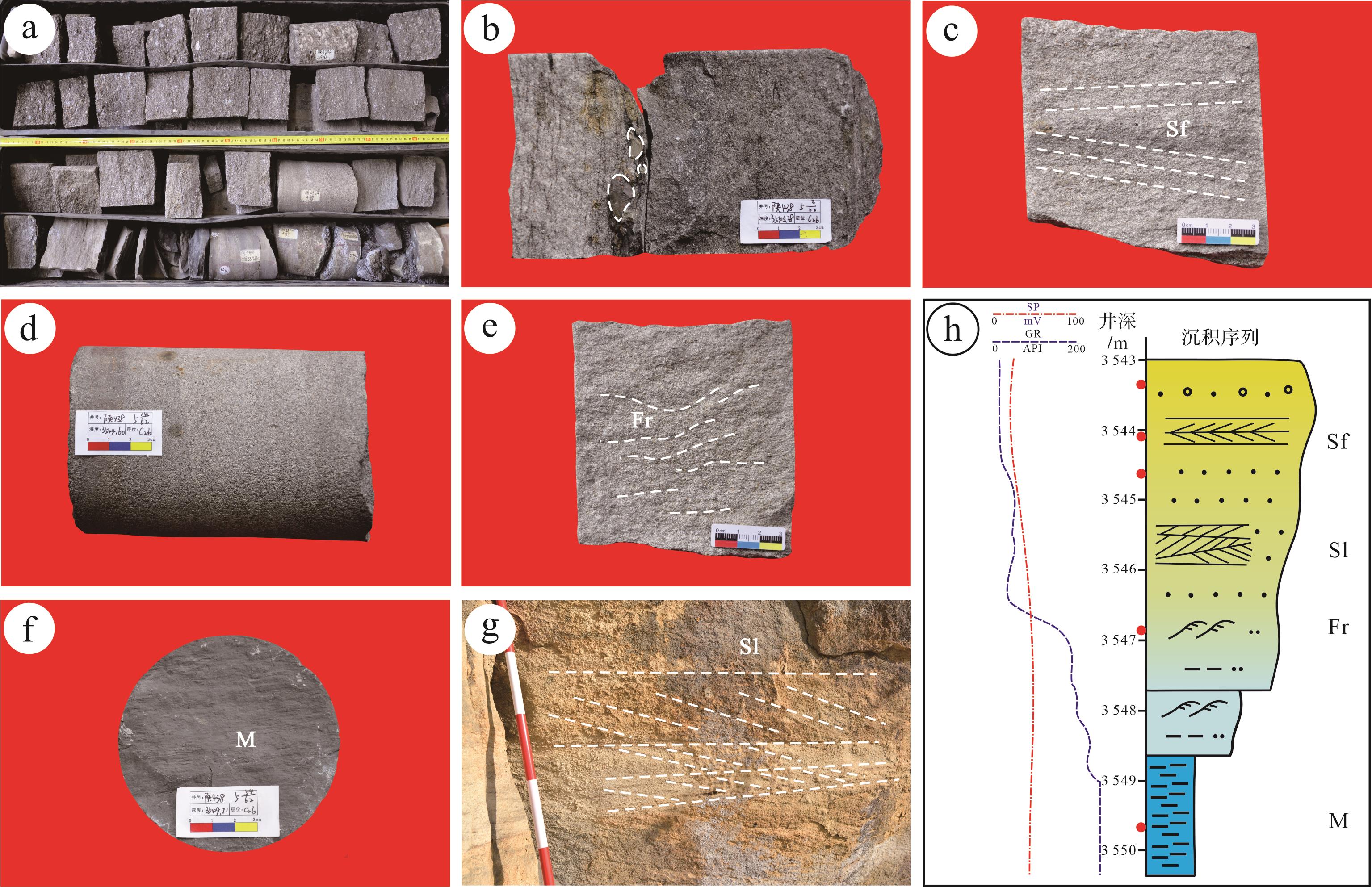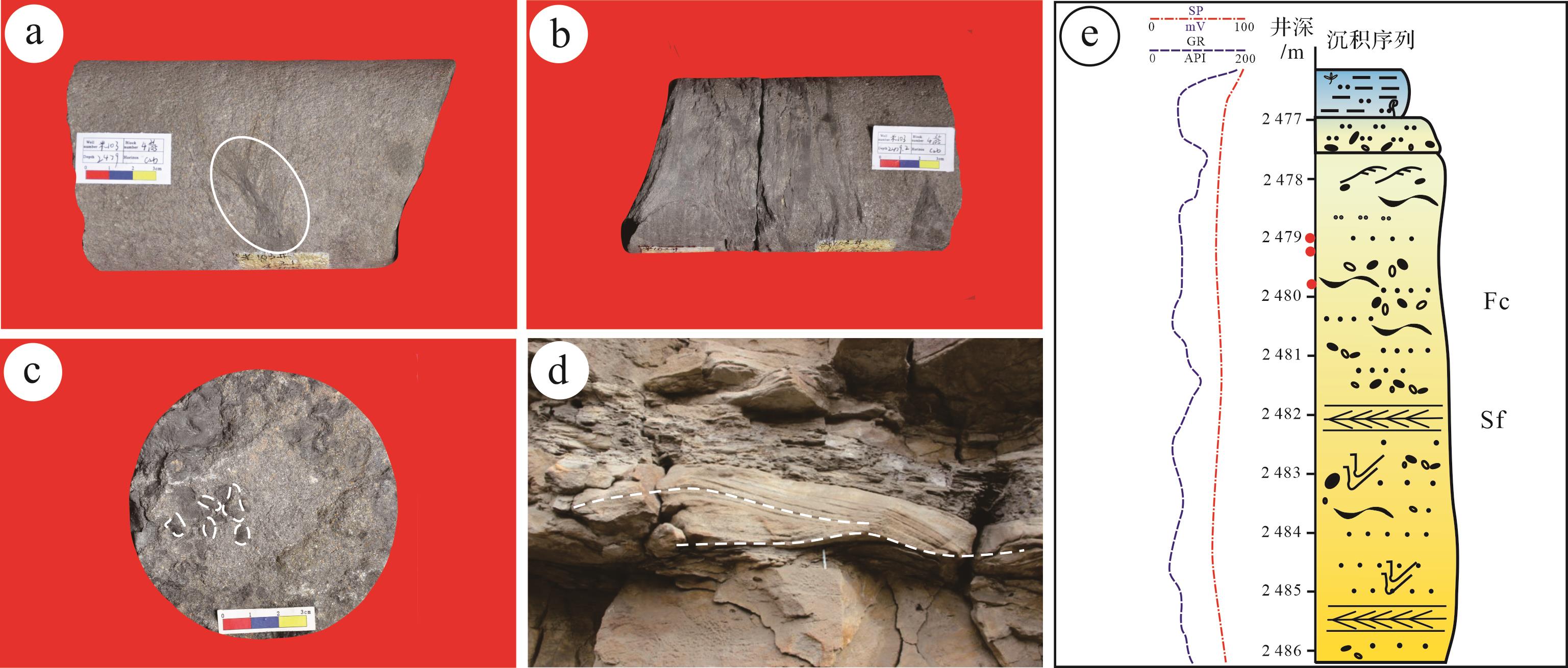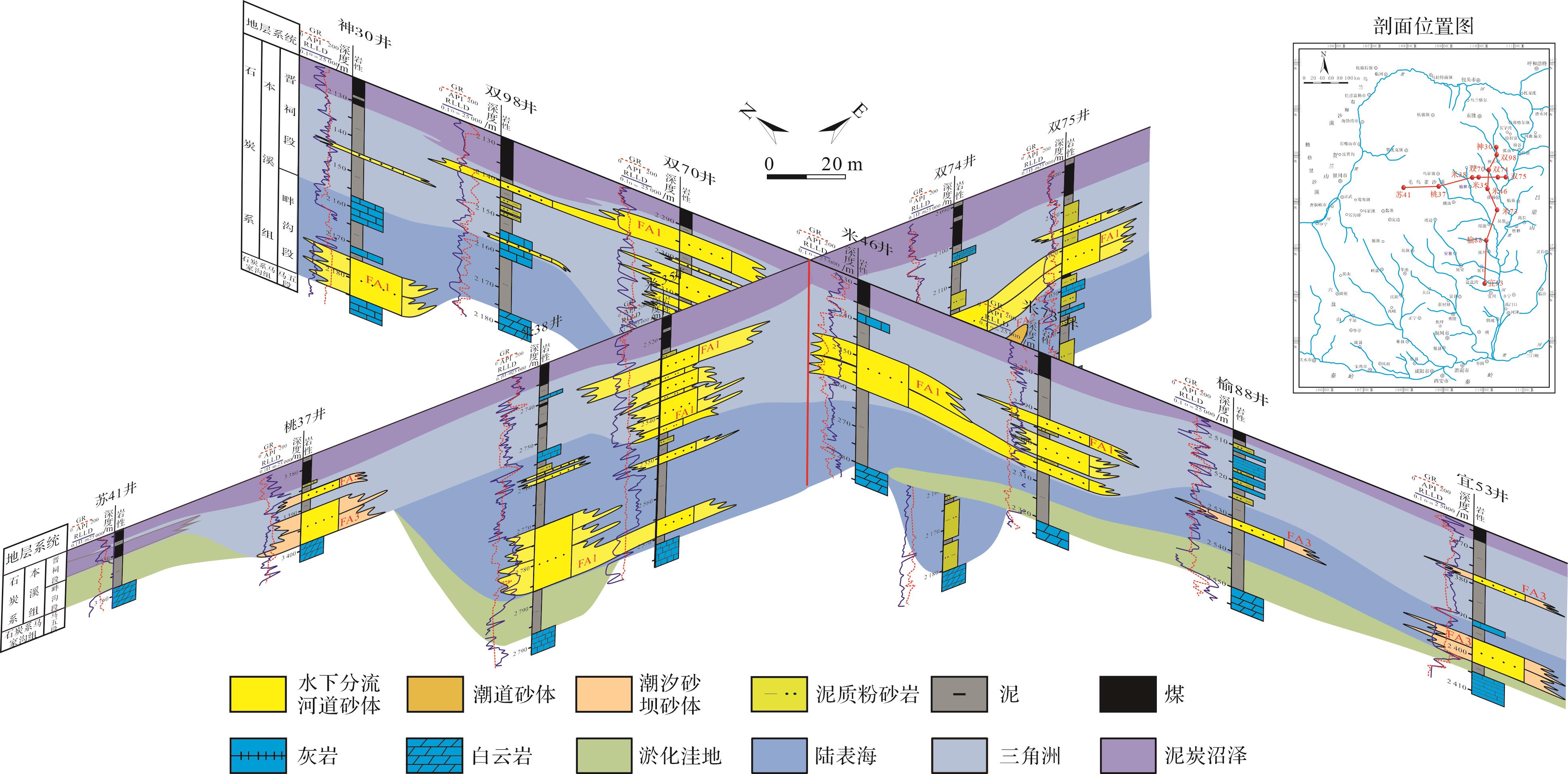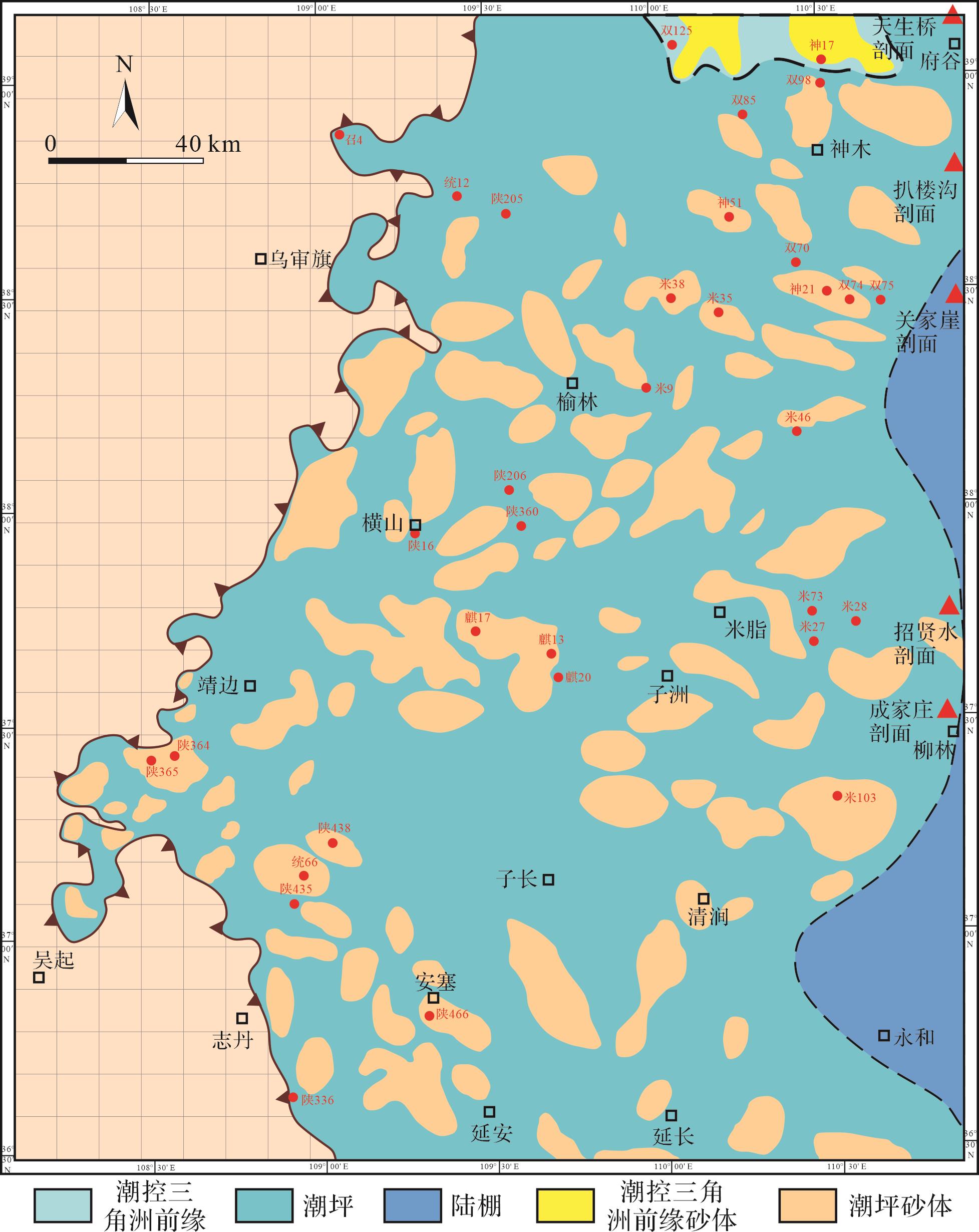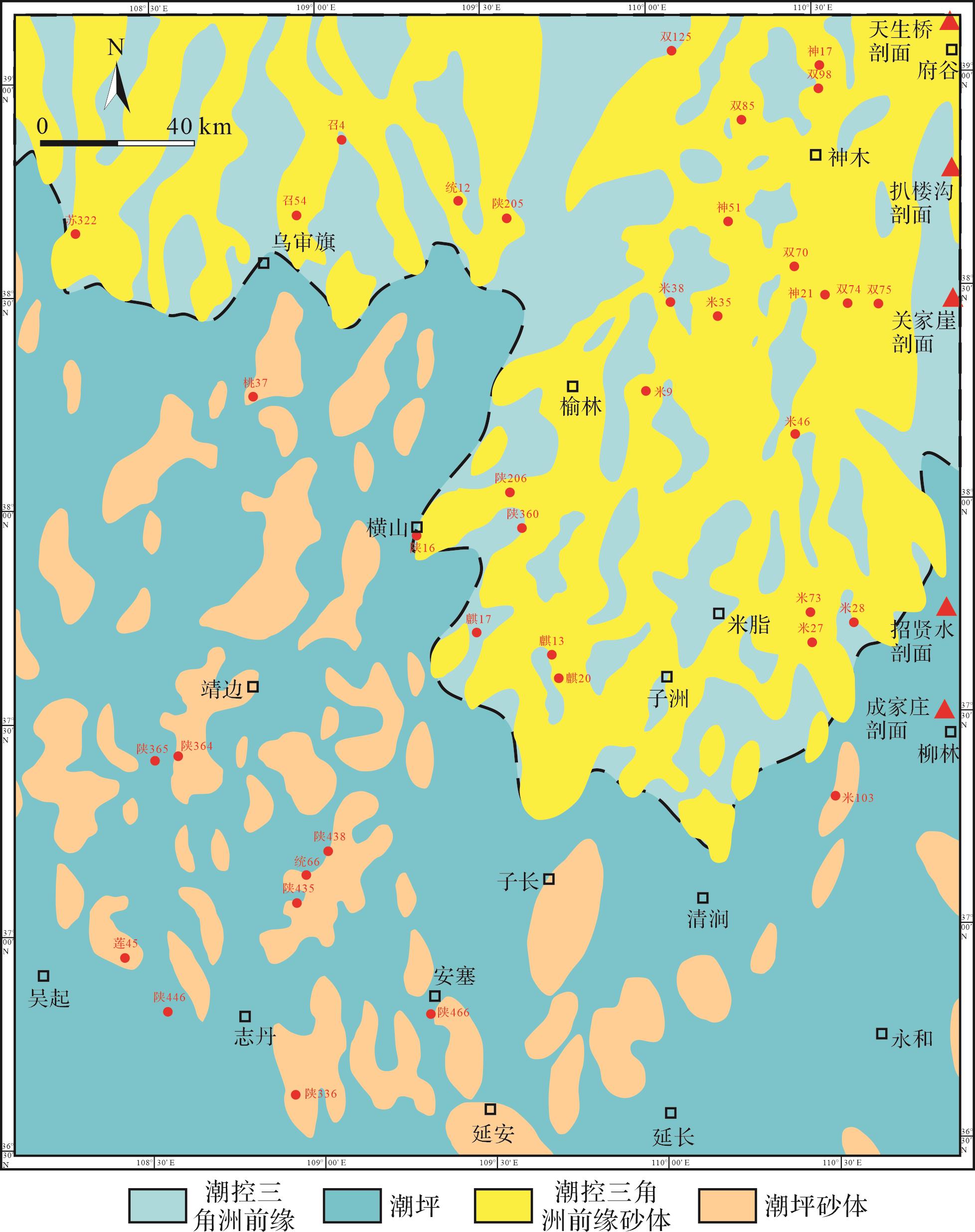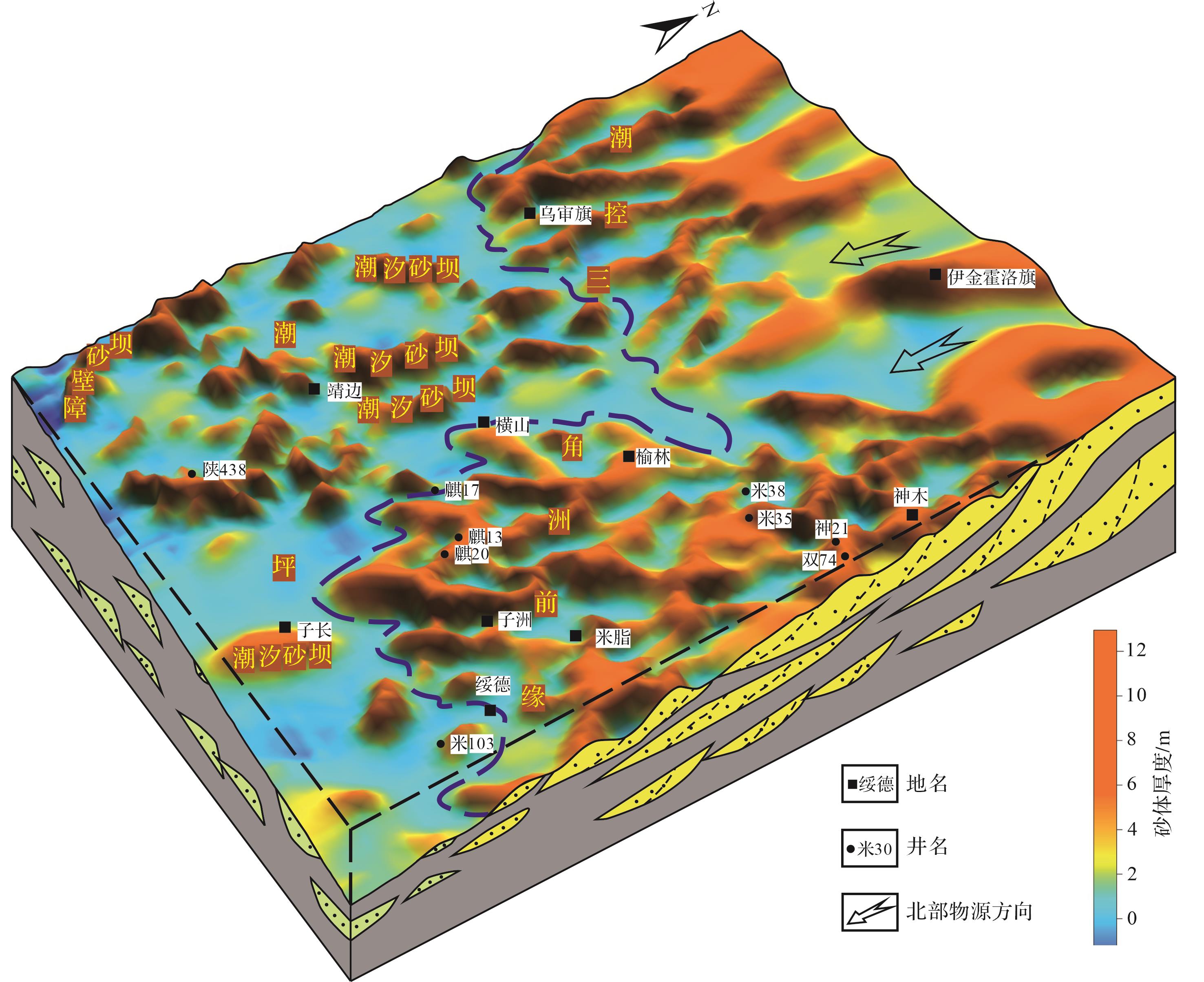HTML
-
鄂尔多斯盆地发育于稳定克拉通盆地上部,为多旋回叠合盆地[1⁃2]。鄂尔多斯盆地中东部上古生界分布广泛,沉积厚度变化大,发育厚度稳定的烃源岩[3⁃8],石英砂岩储层物性好、单井天然气测试取得了良好的效果,显示出良好的勘探潜力[9⁃12]。鄂尔多斯盆地中东部上石炭统本溪组不但是该盆地重要的产气层,也是在早古生代加里东运动之后形成的第一套沉积地层。因此近几年,国内外学者对研究区本溪组的沉积特征进行了大量的研究和讨论。但受沉积模式认识差异的影响,对该地区砂体成因类型的研究还存在不同的认识。其中,部分学者认为研究区本溪组是在开阔陆表海背景下形成的潮控海湾—三角洲环境[13];也有学者认为研究区本溪组是在障壁岛—潟湖海岸沉积环境下形成的[14⁃19];少数学者提出,研究区本溪组发育于潮汐与河流共同作用下的潮汐砂坝—三角洲复合沉积环境,砂体的发育和分布同时受控于潮汐和河流的改造作用[20⁃21]。盆地中东部本溪组砂体具有横向变化快、气藏连续性差的特点,而砂体成因类型研究可以详细地描述本溪组砂体横向变化特征,为本溪组油气藏勘探提供新的研究思路。但目前对于盆地中东部本溪组砂体成因类型缺乏系统的研究,导致砂体成因类型及特征不明确,这严重制约了本溪组油气资源的勘探与开发。
本文基于研究区柳林成家庄、兴县关家崖等6条野外露头剖面的勘察研究,以及对双74井、麒20井等19口井位岩心观察基础上,结合65件岩石薄片和60件粒度分析以及大量测井资料分析,系统开展了本溪组岩相及岩相组合特征研究,讨论本溪组砂体成因类型、砂体展布规律及沉积演化过程,以期为鄂尔多斯盆地中东部油气远景勘探及古地理重建提供有益的参考和借鉴。
-
鄂尔多斯盆地为我国第二大沉积盆地[22⁃24],面积约30万平方千米,处于35°00′~40°30′ N,106°20′~110°30′ E,整体呈现北高南低的不对称矩形状,沉积厚度5 000~10 000 m。盆地内构造简单,可划分6个一级构造单元[25⁃26],研究区位于盆地中东部,北部达府谷,南部至安塞—延长地区,西至吴起,东部以府谷—柳林一带为界,横跨伊陕斜坡及晋西挠褶带[27⁃28](图1a)。

Figure 1. Tectonic location, stratigraphic division, and lithologic feature map of the Benxi Formation in the east⁃central Ordos Basin
早古生代由于受到加里东运动的影响,华北板块整体抬升,盆地接受风化剥蚀。晚古生代,盆地整体沉降接受沉积,其中晚石炭世,海水进入盆地内部,于晚石炭世本溪组时期在盆地中东部形成海侵背景下的海陆过渡相沉积[15,29⁃34](图1b)。本溪组地层主要以铝土质铁质岩为底界,顶部为8#煤层[32],地层产状较平缓,厚度由西南向东北逐渐增大,介于10~110 m。按照岩性差异可将本溪组划分为3个亚段,依次分别为:湖田段、畔沟段和晋祠段[35]。湖田段主要发育含铁铝岩层的泥岩、页岩,多呈紫色。该段铁铝岩,是经历了数次沉积与侵蚀后形成,与下伏马家沟组灰岩地层呈平行不整合接触,为研究区内最显著的岩性标志层[36],该时期地层厚度薄,连续性差,呈零星状,最大厚度仅为12 m左右,受到西部中央古隆起的控制,铁铝岩层主要沿马家沟组古沟槽分布(图1b)。畔沟段主要由砂岩、页岩、粉砂岩以及煤层、灰岩组成,层内可见海、陆生动植物化石,指示其形成于海陆交互环境,顶部发育少量薄层煤,中部发育的灰岩多以单层或多层或透镜状出现在砂页岩、碳质页岩或煤层中,该时期地层海平面快速上升,东部被海水覆盖,对马家沟古沟槽填平补齐,形成了本溪组首个主力砂岩层,沉降中心为延安—安塞一带以及榆林—神木一带,地层最大厚度超过40 m(图1a,b)。晋祠段底部发育一套厚度较大的砂岩,将其称为“晋祠砂岩”[31],主要岩性为灰白、灰绿及灰褐色石英砂岩,含有凝灰质(砂岩)火山物质,在研究区内广泛发育;中部发育深灰色灰岩,将其命名为“吴家峪灰岩”,层内可见透镜状层理、脉状层理等沉积构造,含有大量蜓类等海相动物化石[36];上部发育下煤组,其中8号煤层在研究区内发育较为广泛,但煤层质量较差,该时期地层总体呈现西薄东厚的特征,相比于畔沟段沉积范围扩大,沉降中心为神木—子洲一带,最大厚度超过40 m(图1a,b)。
-
岩相通常是指在某种水动力条件下形成的岩性和沉积构造组合[37],可以根据岩相特征来判断沉积物的搬运方式,并对该时期的水动力条件以及沉积作用机理等进行分析[38],是砂体成因研究的重要部分。通过对鄂尔多斯盆地中东部本溪组野外剖面观测、岩心观察,在研究区内共识别出以下12种岩相类型(表1、图2)。
-
岩相组合是指不同岩相的垂向组合,反映的是某种特定的水动力条件连续变化的状态及过程,是判别沉积环境的重要手段[39]。按照岩相在剖面上的共生关系,本文以12种岩相类型和每种岩相所代表的环境意义将研究区岩相划分为6种岩相组合。
-
岩相组合FA1,以正粒序为主,通常底部具冲刷面,冲刷面之上广泛发育块状砾岩相(Gm),其中砾石呈高度磨圆,叠瓦状排列,且具有定向性,其上被槽状交错层理砂岩相(St)、板状交错层理砂岩相(Sp)覆盖,砂体间见灰黑色泥岩,该岩相组合反映了潮控三角洲前缘水下分流河道的沉积特征。
-
岩相组合FA2,具有正粒序结构,底部多见不规则冲刷面,冲刷面之上发育板状交错层理砾岩相(Gp),中部发育纹层向下收敛的槽状交错层理砂岩相(St)或者板状交错层理砂岩相(Sp),上部发育双向的羽状交错层理砂岩相(Sf)以及泥岩相(M),该岩相组合反映了潮道沉积特征。
-
岩相组合FA3,岩性多为灰白色中—细粒石英砂岩,其顶底接触面相对平整,底部发育板状交错层理砂岩相(Sp)和变形层理粉砂岩相(Fd),上部发育羽状交错层理砂岩相(Sf)和冲洗交错层理砂岩相(Sl)。在砂岩中可见潮汐流作用形成的泥质披盖层和泥砾碎片,泥砾沿着层系分布,该岩相组合反映了潮汐砂坝沉积特征。
-
岩相组合FA4,正粒序,整体以深灰色粉—细砂岩为主,单层砂体厚度较薄。在下部发育板状交错层理细砂岩相(Sp)和羽状交错层理砂岩相(Sf),而在上部常出现脉状层理粉细砂岩相(Fcf)、波状层理粉细砂岩相(Fcw)、透镜状层理泥质粉砂岩相(Fcl)的变化规律,部分可见薄煤层(C),该岩相组合反映了潮坪(砂坪—混合坪)沉积特征。
-
岩相组合FA5,整体上具有向上变粗的趋势,沉积序列底部为泥岩相(M)以及局部可见块状层理泥灰岩相(Lm)向上过渡为沙纹交错层理粉砂岩相(Fr)或者羽状交错层理砂岩相(Sf),上部可见冲洗交错层理砂岩相(Sl)和羽状交错层理砂岩相(Sf)。顶部可见细砾岩沉积,砾石颗粒的直径为1~2 cm,分选磨圆较好,为高能波浪环境所形成,该岩相组合反映了障壁砂坝沉积特征。
-
岩相组合FA6,砂体以中—细砂岩为主,由于风暴的强烈影响,部分泥岩砾被卷起,呈紊乱状分布,发育羽状交错层理砂岩相(Sf)和潮汐层理砂岩相(Fc),该岩相组合反映了潮汐风暴—陆棚沉积特征。
2.1. 岩相特征
2.2. 岩相组合特征
2.2.1. FA1:Gm⁃St⁃Sp
2.2.2. FA2:Gp⁃St/Sp⁃Sf⁃M
2.2.3. FA3:Sp⁃Fd⁃Sf⁃Sl
2.2.4. FA4:Sp⁃Sf⁃Fc⁃C
2.2.5. FA5:M⁃Lm⁃Fr/Sf⁃Sl⁃Sf
2.2.6. FA6:Sf⁃Fc
-
根据野外剖面及岩心中识别出的岩相及岩相组合特征,同时结合岩石薄片、粒度分析以及测井资料分析,在研究区内识别出水下分流河道砂体、潮道砂体、潮坪(砂坪—混合坪)砂体、潮汐砂坝砂体、障壁砂坝砂体、潮汐风暴—陆棚砂体6种砂体类型。
-
该类砂体主要发育于潮控三角洲前缘,是分流河道延伸到水下部分[40],主要受到河流作用影响、潮汐作用影响有限,在研究区北部神21井一带晋祠段中具有典型的特征。砂体以中—粗粒砂岩为主,厚5~15 m,多发育槽状、板状等交错层理(图3a,b,d~f),由于受到潮汐作用,局部可见潮汐层理(图3c,g)。垂向上整体呈现正粒序结构,向上沉积构造发育规模减小,底部多见冲刷面,砾石以叠瓦状定向排列,指示单向水流特征。碎屑组分以石英、岩屑为主,分选性较好,磨圆为次棱角—次圆状(图4a),粒度概率累积曲线显示跳跃总体占比大,斜率值较高,说明水流能量中等—相对较强的特点(图5a)。与岩相组合FA1相对应,典型的岩相组合序列为:块状层理砾岩相(Gm)—槽状交错层理砂岩相(St)—板状交错层理砂岩相(Sp)(图3h)。

Figure 3. Sedimentary characteristics of underwater distributary channel sand bodies from the Benxi Formation in the east⁃central Ordos Basin
-
该类砂体主要发育于河口湾和潮下带,是潮汐作用向陆方向的延伸,属于高能水动力环境[19],在研究区北部双74井一带畔沟段中具有典型的特征。下部以含砾粗砂岩为主(图6d,f),具有冲刷面及泥砾,泥砾多呈定向排列,与层理面平行,指示水流方向,多见泥披层(图6a)。由于潮汐水道水流能量较强,砂体内部发育多种交错层理,如槽状交错层理、板状交错层理、羽状交错层理等(图6b,c,e,g),其中羽状交错层理作为双向水流标志层理指示存在潮汐双向水流作用,该类砂体厚2~5 m。整体呈现正粒序结构,多发育泥岩。碎屑组分以石英、岩屑为主,分选性较差,磨圆为次棱角状(图4b),粒度概率累积曲线显示跳跃总体所占比例大,粒度偏粗,斜率值较高,悬浮总体次之,说明潮道水流能量强(图5b)。与岩相组合FA2相对应,典型的岩相组合序列为:板状交错层理砾岩相(Gp)—槽状/板状交错层理砂岩相(St/Sp)—羽状交错层理砂岩相(Sf)—泥岩相(M)。多期潮汐水道可在垂向上叠加,进而形成岩相序列的叠加,如常见序列Gm-St/Sp-Sf-M-St/Sp-Sf-M的叠加样式(图6h)。
-
该类砂体主要发育于潮下带,为高能水动力环境,主要受到潮汐作用影响[41],在研究区中部麒20井一带晋祠段中具有典型的特征。砂体以中砂岩为主,厚5~20 m,泥披层较发育(图7d),多见板状交错层理、羽状交错层理、冲洗交错层理及变形层理等(图7b,c,e,g),其中,研究区内双向交错层理的广泛发育表明潮汐双向水流的存在及主导作用。顶部可见泥砾,部分被风暴改造后呈撕裂状,反映出潮汐能量的增强,整体显示出向上厚度变厚,水动力增强的潮汐沉积特征(图7a,f)。一般来说,在垂向上呈粒度变粗的反粒序结构,有时也为均质或不发育粒序层[42]。碎屑组分以石英为主,分选性较好,磨圆为次圆状(图4c),粒度概率累积曲线显示跳跃总体占比最大,斜率较高(图5c)。与岩相组合FA3相对应,典型的岩相组合序列为:板状交错层理砂岩相(Sp)—变形层理粉—细砂岩相(Fd)—羽状交错层理砂岩相(Sf)—冲洗交错层理砂岩相(Sl)(图7h)。
-
该类砂体包括砂坪及混合坪砂体,主要发育于潮间带,潮汐水体能量相对较高,主要受到潮汐作用影响,在研究区中部陕365井一带晋祠段中具有典型的特征。下部多为砂坪砂体,以中—细砂岩为主,发育板状交错层理、羽状交错层理等(图8e,f),双向交错层理的出现指示潮汐双向水流作用,在砂岩中也可见潮汐流作用形成的泥质披盖层和泥砾碎片,部分泥砾碎片在风暴搅动后呈撕裂状(图8d,g)。向上过渡为混合坪砂体,粒度变细,以细砂岩、粉细砂岩为主,夹薄层泥岩,形成典型的潮汐韵律,是在涨退潮期与停潮期接替出现背景下而形成,因砂泥供应量的不同而发育不同类型潮汐层理,包括脉状层理、波状复合层理、透镜状层理(图8a~c)。该类砂体厚2~20 m,垂向上整体呈现正粒序结构。碎屑组分以岩屑、杂基为主,分选性中等,磨圆为次棱状(图4d),粒度概率累积曲线跳跃总体占比大,斜率较高,悬浮总体占比少,斜率较低(图5d)。与岩相组合FA4相对应,典型的岩相组合序列为:板状交错层理砂岩相(Sp)—羽状交错层理砂岩相(Sf)—脉状层理粉细砂岩相(Fcf)—波状复合层理粉细砂岩相(Fcw)—透镜状层理泥质粉砂岩相(Fcl)—煤层(C)(图8h)。
-
该类砂体发育在潟湖与广海之间,主要受到海洋波浪作用[43],在研究区南部陕438井一带畔沟段中具有典型的特征。下部发育泥岩(图9f),且局部可见块状层理泥灰岩,其上以粉砂岩为主,发育沙纹层理(图9e),向上粒度变粗,以中—细砂岩为主,发育冲洗交错层理、羽状交错层理等(图9c,g),顶部可见大量砾石(图9b),该类砂体厚2~5 m,且砂体表现出颗粒分选性好和磨圆度好的特点(图9a,d),反映受长期的冲刷和淘洗作用,整体呈现逆粒序结构,且野外可见波痕,反映水动力条件逐渐增强的波浪作用环境。碎屑组分以石英为主,分选性较好,磨圆为次圆状(图4e),粒度概率累积曲线显示跳跃总体占比大,斜率较高(图5e)。与岩相组合FA5相对应,典型的岩相组合序列为:泥岩相(M)—块状层理泥灰岩相(Lm)—沙纹层理粉砂岩相(Fr)—冲洗/羽状交错层理砂岩相(Sl/Sf)(图9h)。
-
该类砂体发育于陆棚,主要受到海洋作用以及潮汐影响,在研究区南部米103井一带晋祠段中具有典型的特征。砂体以中—细砂岩为主,厚5~15 m,砂岩中发育羽状交错层理、潮汐层理,以及由正常潮汐作用继续改造形成风暴沉积的典型标志丘状交错层理(图10d),砾岩多为石英砾岩,磨圆好,分选差,形成扇状、倒小字型或杂乱排列构造(图10a,b),由于风暴的强烈影响,部分泥岩砾被卷起,呈紊乱状分布(图10c)。碎屑组分以石英为主,分选性较差,磨圆一般(图4f),粒度概率累积曲线为三段式,斜率较小(图5f)。与岩相组合FA6相对应,典型的岩相组合序列为:羽状交错层理砂岩相(Sf)—潮汐层理砂岩相(Fc)(图10e)。
3.1. 水下分流河道砂体
3.2. 潮道砂体
3.3. 潮汐砂坝砂体
3.4. 潮坪(砂坪—混合坪)砂体
3.5. 障壁砂坝砂体
3.6. 潮汐风暴—陆棚砂体
-
基于研究区内本溪组砂体的整体展布情况,优选了一条近东西方向(横向)与一条近南北方向(纵向)的剖面来对砂体展布规律进行分析。
由东西向砂体剖面对比图(图11)可以看出,整体地层具有西薄东厚的特征,东侧砂体主要发育于晋祠段,中、西部则以畔沟段为主。西部苏41井地层厚度最小,且无砂体发育,中东部米35井处砂体沉积厚度最大,约为20 m,东部砂体发育程度优于西部。砂体横向连通性一般,主要为潮控三角洲前缘水下分流河道砂体,砂体呈“顶平底凸”形态,单砂体厚4~6 m,宽1.5~3.2 km,长4.8~9 km,由于河道改道常形成多期砂体叠置发育,沉积厚度较大,但砂体延伸距离较短。砂体在垂向上具有向东迁移的特征。
由南北向砂体剖面对比图(图11)可以看出,研究区整体地层具有北厚南薄的特征,砂体主要发育于晋祠段,中部双70井、米46井、米73井区域发育程度较好,双70井处地层厚度最大,指示沉积中心,砂体大量发育,单个砂体厚度可达10 m,砂体间夹有薄层泥岩,主要为潮控三角洲前缘水下分流河道砂体,单砂体厚3~5 m,宽2~6 km,长6~12 km。南部砂体厚度相对较薄,且连通性较差、延伸距离短,表明受到潮汐作用明显。砂体在垂向上具有从南北两侧共同向中部沉积中心迁移的特征。
-
通过对研究区野外剖面进行观察,结合大量钻井岩心的粒度分析、岩石薄片分析,以及大量的测井资料解释结果,分别统计湖田段、畔沟段和晋祠段砂体厚度。基于大量钻井厚度数据,以及钻井间的砂体对比,绘制鄂尔多斯盆地中东部本溪组不同沉积时期砂体平面展布图。
其中,湖田段沉积期,研究区在区域拉张的构造背景条件下,沉积基底沉降并开始接受沉积充填,该时期华北板块南北两端处于小陆块初始碰撞拼接阶段,造山作用弱[29⁃32],物源供给不强,表现为不发育砂体沉积,主要发育铁铝质层。
畔沟段沉积期,北部古亚洲洋构造域中的白乃庙等小板块与华北板块发生碰撞,形成小型造山带,为研究区北部提供物源,发育了小型三角洲体系[44⁃46];而研究区南部受南北秦岭与华北板块的共同造山作用,形成了南部物源区,也发育了小型三角洲体系[29⁃32]。但该时期由于海侵作用,海平面快速上升,研究区东部地区被海水覆盖,南北物源体系进入盆地后,在潮汐作用的强烈改造下,原有三角洲被破坏,其形态发生改变,砂体呈孤立补丁状分布,空间连通性较差[20],其延伸方向呈现出较显著的特点,大多数均与岸线斜交或垂直,多呈北东—南西和北西—南东向展布,其与潮汐水流方向有关,厚2~10 m。砂体类型主要为潮汐砂坝砂体,该时期以潮汐作用为主导,河流作用受限(图12)。

Figure 12. Sand body layout of the Pangou member from the Benxi Formation in the east⁃central Ordos Basin
晋祠段沉积期,经历造山作用减弱后,南、北两个方向的造山作用再次增强,为本溪期物质来源最丰富的时期[47⁃48],其中研究区北部再次发育三角洲体系。此时尽管海平面仍在持续升高,但可容纳空间增长速率显著低于物源供给速率,北部三角洲往盆内不断进积,三角洲沉积体系较畔沟段沉积范围扩大,形成了晋祠砂体[29⁃32],该砂体发育规模较大,也受到了潮汐作用的改造,但其连通性较好,呈南北向的条带状交织在一起。南部潮汐作用较强,对砂体的改造程度较大,将其切割成孤岛状的砂坝形式,连通性较差[20],砂体展布整体具有沿南—北向特征,表明该时期潮汐水流在以南到北之间流动,北部受到潮汐作用影响相对南部较小,很大程度上保留了三角洲形态(图13)。
-
根据本溪组砂体成因类型、形态及砂体展布特征,结合沉积环境分析,建立潮控三角洲—潮坪及障壁岛复合沉积体系模式。众所周知,海岸带的潮汐作用,可以应用潮差进行约束,潮差为相邻高潮潮高与低潮潮高的差,根据潮差规模可分为小潮差(<2 m)、中潮差(2~4 m)和大潮差(>4 m)三种类型[49⁃50]。障壁岛—潟湖体系的形成是以小潮差为背景,具有与岸线近于平行的障壁砂坝。大潮差背景下,海岸为潮控环境,砂坝受潮流作用的控制,其走向与潮流方向一致。中潮差背景介于两者之间,潮汐对砂体有一定的切割作用,但仍然能看出原始的形貌[20,32]。研究区北部砂体发育规模较大,但受到了以中小潮差背景为主的潮汐作用改造,主要发育潮控三角洲前缘沉积,以水下分流河道砂体为主,岩性多为中—粗砂岩,底部可见大量砾石,分选、磨圆度较好,杂基含量较低,多发育槽状、板状等交错层理,由于受到潮汐作用,局部可见潮汐层理发育。单砂体横剖面呈“顶平底凸”形态,平面上呈条带状或连片状展布。中南部受到以大潮差背景为主的潮汐作用改造,主要发育潮汐砂坝砂体,粒度主要为粗砂岩,部分含砾,砂坝侧翼多为中—细砂岩,多见板状交错层理、羽状交错层理及冲洗交错层理等。单砂体在横剖面上呈“底平顶凸”形态。西部临近中央古隆起水体相对较浅,受到了以中小潮差背景为主的潮汐作用改造,在水下古隆起之上发育障壁砂坝砂体,多以孤岛状的砂坝形式分布(图14)。结合前人的研究成果及本次的分析结果,认为最有利砂体区处于研究区北部榆林—子洲一带,该带砂体受潮汐改造较强,成熟度高,砂体厚度较大,成藏条件最好;南侧靖边—子长地区略差,为次级有利区。该模式的建立对鄂尔多斯盆地中东部本溪组的砂体类型精细解剖,具有重要的地质理论指导意义。
4.1. 砂体横向展布及发育特征
4.2. 砂体平面分布特征
4.3. 沉积模式
-
(1) 研究认为鄂尔多斯盆地中东部本溪组共发育12种岩相类型,研究区内可识别出6种岩相组合,对应水下分流河道、潮道、潮坪(砂坪—混合坪)、潮汐砂坝、障壁砂坝、潮汐风暴—陆棚6类成因类型。
(2) 湖田段沉积期,华北板块南北两端处于小陆块初始碰撞拼接阶段,造山作用弱,物源供给不强,表现为不发育砂体;畔沟段沉积期海平面快速上升,研究区东部地区被海水覆盖,南北物源体系进入盆地后,主要受到以大潮差为背景的潮汐作用改造,砂体类型主要为潮汐砂坝砂体,同时发育小规模的水下分流河道砂体、潮道砂体和潮坪(砂坪—混合坪)砂体;晋祠段沉积期,南、北两个方向的造山作用增强,为本溪期物质来源最丰富时期,其中研究区北部物源供给充足,发育三角洲体系,此时海平面虽然持续上升但是可容纳空间增长速率显著低于物源供给速率,北部三角洲往盆内不断进积,使得砂体发育规模较大,但受到以中小潮差背景为主的潮汐作用改造,主要为水下分流河道砂体,中南部受到以大潮差背景为主的潮汐作用改造,主要发育潮汐砂坝砂体,西部临近中央古隆起水体相对较浅,受到了以中小潮差背景为主的潮汐作用改造,发育障壁砂坝砂体、潮道砂体和潮坪(砂坪—混合坪)砂体。

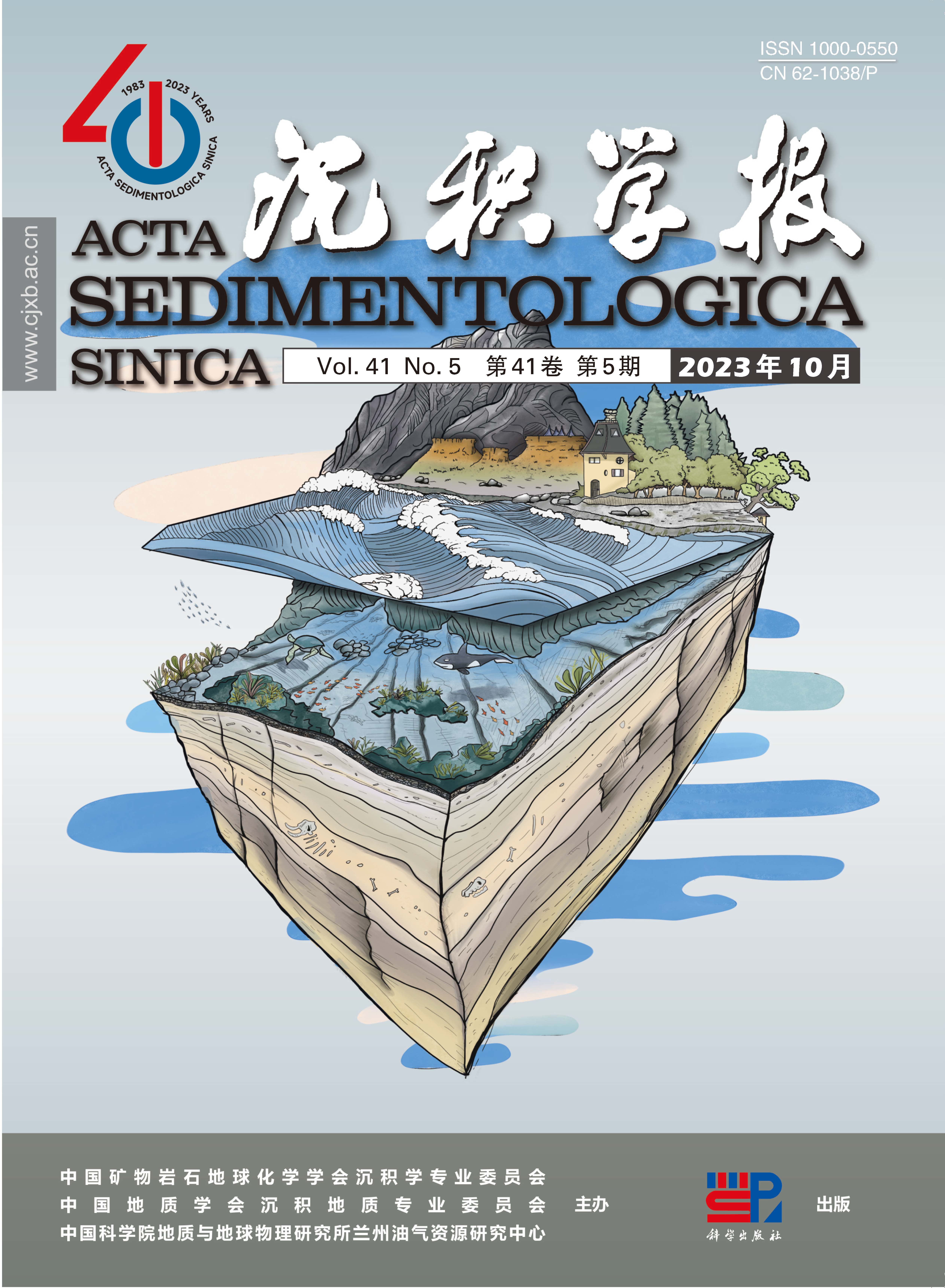
















 DownLoad:
DownLoad:
